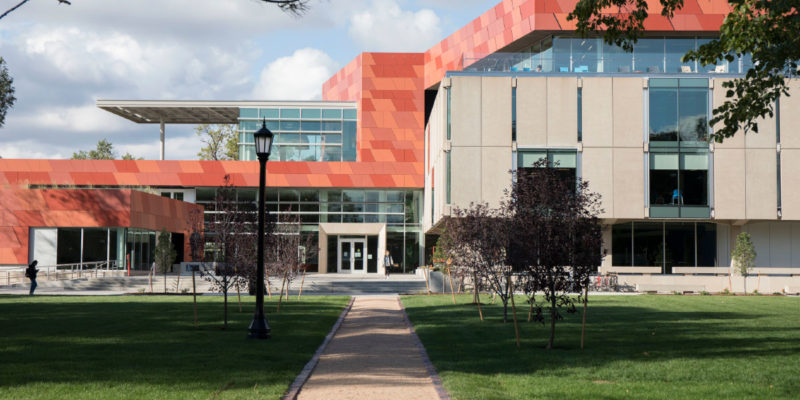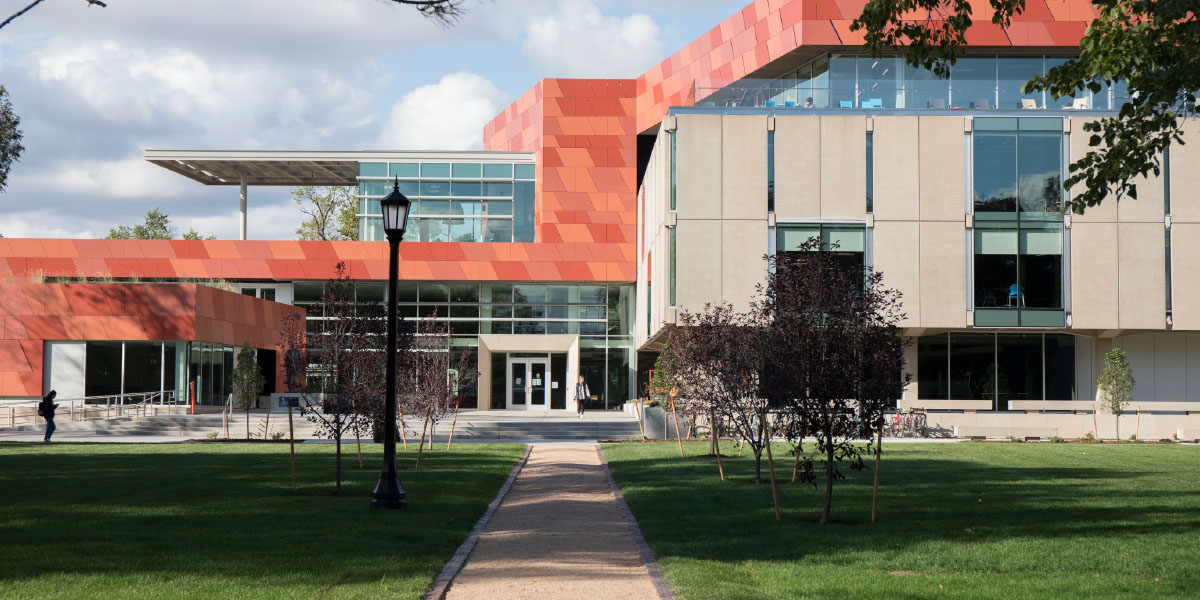Colorado College, located in Colorado Springs, recently completed a $45 million renovation and expansion that transformed its Tutt Library into the country’s largest carbon neutral, net-zero energy academic library. A driving force for the project, which received a 2017 NACUBO Innovation Award, was CC’s strategic plan that identified the need for a library that supported our institution’s unique academic calendar.
Colorado College operates on the Block Plan, in which its approximately 2,000 students take one course at a time for three-and-a-half weeks each. This compresses class schedules and intensifies the use of study space. Before the renovation, the library was underutilized; its space, able to seat only 20 percent of the students, wasn’t flexible enough for the Block Plan. Now, Tutt Library can seat more than 50 percent of the students, offers 17 classroom/instructional spaces, includes space for community events, and consolidates a host of offices and academic resources.
An Intellectual Hub
Among those resources are the Center for Immersive Learning and Engaged Teaching—which encompasses the offices of sustainability, community engagement, international programs, and academic technology—as well as the Help Desk, Crown Faculty Center, and Colket Center for Academic Excellence.
The library also includes a geographical information systems lab; a data visualization lab, where students can display large data sets in a pictorial or graphical format to help identify patterns or solve problems; and a technology sandbox that allows students to experiment with virtual reality technology, 3-D printing, and building computers. The convergence of these resources makes the library the intellectual hub of campus, where all facets of learning connect.
To support CC’s academic mission, the decades-old library needed substantial increases in power and technology infrastructure. When Tutt Library was originally constructed in 1962, energy consumption was of little concern because costs were low. As energy costs rose, however, we focused on increasing efficiency across the campus—typically by designing buildings first and then trying to fit in sustainable features. Over the years, this reactive strategy led to an important lesson: High-performance sustainable buildings are achievable within project budgets only when you integrate features from the programming phase of design.
With Tutt Library, we took the proactive approach of setting net zero as a goal when programming for the project began. Identifying this priority early on saved time and money. The college provided performance specifications to the design team, which used hourly weather, space utilization, and historical data to accurately model the energy and carbon performance throughout the design process. Contractors, added to the team early in the process, provided costing at each phase of design and design alternatives. As a result, the college never had to discuss what to cut in order to put energy savings into the project or talk about redesigning to achieve net zero.
Bigger, but More Efficient
Before the renovation, Tutt Library consisted of 91,501 square feet of space with an annual energy cost of $1.19 per square foot per year and intensity of 106 kBtu per square foot per year. The updated library now encompasses 94,317 square feet of net-zero energy, cutting-edge space; the final design offsets 1,538 metric tons of carbon dioxide annually. In addition to increasing glazing to 30 percent of the building’s envelope, the design added terraces on each level to offer views of Pikes Peak. Exterior terraces and walkways now use a snow melting system to maintain access and reduce the cost of snow removal.
A major innovation is the building’s system diversity. The renovated library has four synchronous sources of electrical power, all with the ability to feed the grid: a geothermal (geo-exchange) bore field, 115 kW rooftop photovoltaic solar, 400 kW offsite photovoltaic solar, and a 130 kW combined heat and power (CHP) system. It also has five sources of heating and two sources of cooling. Water-source variable refrigerant flow (VRF) heat pumps efficiently move heating and cooling around the building, which also has hydronic radiant heat. The heat produced by the pumps can be sent to the geothermal heat bore field or to the campus chilled water system.

Tutt Library relies on a complex system of heat exchangers, energy meters, and automated controls to fulfill the college’s goal of maximizing building performance and occupant comfort, while minimizing operational costs, energy consumption, and carbon emissions. The features added to achieve carbon neutral, net-zero energy use totaled $1.2 million. We’ve reduced annual utility costs by $83,000, using current utility pricing, for a simple payback of 15.6 years.
The system diversity improves operational effectiveness and reduces the risk of service interruptions. Redundant utility sources enable the library to operate at optimum efficiency while controlling utility rates and improving system reliability. For example, the building can accept heat from the geothermal heat exchanger, the campus chilled water distribution, the CHP system, high-efficiency boilers, or the campus high-temperature hot water distribution system. Its heating systems can be powered by one or two grid connections and/or the on-site CHP system.
The CHP system consists of two natural gas-fired microturbines that operate in parallel with the grid. Our locally available grid electricity predominantly originates from coal, which allows us to use the microturbines for fuel switching and acquire electricity with lower carbon emissions. If the grid electrical power is lost, the turbines will carry the building’s critical infrastructure, helping to mitigate the risk of losing the building function. The building automation system has electrical metering to modulate the turbines to match the building demand while connected to the utility grid.
United in Mission
During construction, which was accomplished within budget, supervisors from CC’s technical trade shop met weekly with engineers to ensure that the equipment installations met the project requirements. Staff from the facilities department also participated in building commissioning, to ensure the building systems perform in accordance with the project specifications. After a rigorous 15-month construction schedule, Tutt Library opened in August 2017.
With these kind of collaborations, designing and constructing the renovated library united the campus community to accomplish the college’s mission, core values, and strategic goals while advancing both the study and practice of environmental sustainability. In fact, since 2008, the campus has reduced energy intensity per square foot by 33.4 percent. The library project put into motion years of planning and actions intended to reduce CC’s carbon footprint, and it has redefined our approach to achieving high-performance buildings by emphasizing collaboration and communication at all levels.
SUBMITTED BY Robert Moore, senior vice president of finance and administration; and Mark Ferguson, campus operations and plant manager, Colorado College, Colorado Springs.



